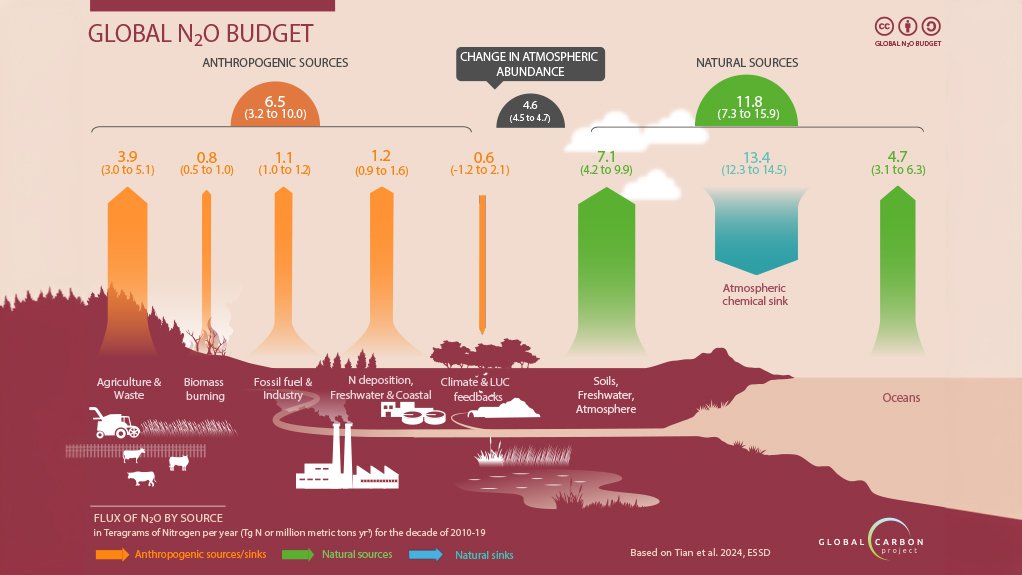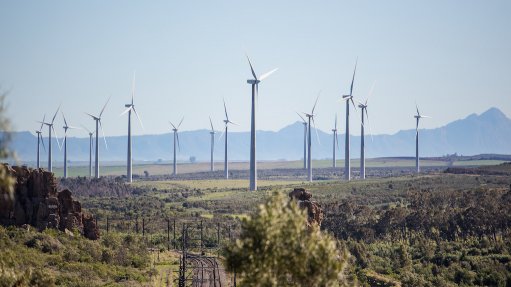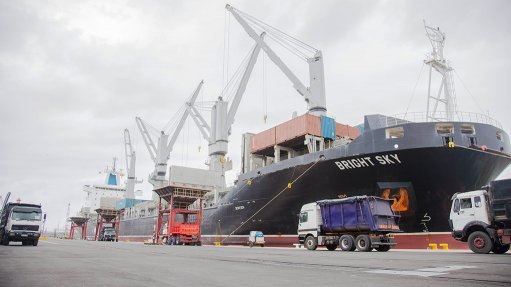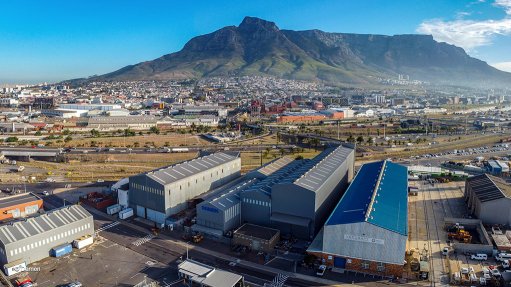Nitrous oxide emissions grew by 40% from 1980 to 2020, study finds
Emissions of nitrous oxide – a greenhouse gas (GHG) said to be more potent than CO2 or methane – continued unabated between 1980 and 2020, a year when more than ten-million metric tons were released into the atmosphere primarily through farming practices, according to a new report by the Global Carbon Project.
Agricultural production accounted for 74% of human-driven nitrous oxide emissions in the 2010s – attributed primarily to the use of commercial fertilisers and animal waste on croplands – according to the report ‘Global Nitrous Oxide Budget 2024’, led by researchers from Boston College and published on June 12 in the journal Earth System Science Data.
In an era when GHG emissions must decline to reduce global warming, in 2020 and 2021 nitrous oxide flowed into the atmosphere at a faster rate than at any other time in history, the report points out.
Excess nitrogen contributes to soil, water and air pollution. In the atmosphere, it depletes the ozone layer, and exacerbates climate change.
Agricultural emissions reached eight-million metric tons in 2020, a 67% increase from the 4.8-million metric tons released in 1980, according to the study, which was produced by a team of 58 researchers from 55 organisations in 15 countries.
“Nitrous oxide emissions from human activities must decline in order to limit global temperature rise to 2 °C as established by the Paris Agreement. Reducing nitrous oxide emissions is the only solution since at this point no technologies exist that can remove nitrous oxide from the atmosphere,” says report lead author Hanqin Tian, the Schiller Institute Professor of Global Sustainability at Boston College.
The concentration of atmospheric nitrous oxide reached 336 parts per billion in 2022, a 25% increase over pre-industrial levels that far outpaces predictions previously developed by the Intergovernmental Panel on Climate Change, Tian explains.
“This emission increase is taking place when the global GHGs should be rapidly declining towards net zero emissions if we have any chances to avoid the worst effects of climate change,” Tian says.
The world’s farmers used 60-million metric tons of commercial nitrogen fertilisers in 1980. By 2020, the sector used 107-million metric tons. That same year, animal manure contributed 101-million metric tons for a combined 2020 usage of 208-million metric tons.
The unfettered increase in a GHG with a global warming potential about 300 times larger than CO2, presents dire consequences for the planet, the report warns.
Drawing on millions of nitrous oxide measurements taken during the past four decades on land and in the atmosphere, freshwater systems, and the ocean, Tian says the researchers have generated the most comprehensive assessment of global nitrous oxide to date.
The researchers examined data collected around the world for all major economic activities that lead to nitrous oxide emissions and reported on 18 anthropogenic and natural sources and three absorbent “sinks” of global nitrous oxide.
The top ten nitrous oxide emission-producing countries are China, India, the US, Brazil, Russia, Pakistan, Australia, Indonesia, Türkiye and Canada, the researchers found.
Some countries have seen success implementing policies and practices to reduce nitrous oxide emissions, according to the report. Emissions in China have slowed since the mid-2010s as have emissions in Europe during the past few decades.
In the US, agricultural emissions continue to creep up while industrial emissions have declined slightly, leaving overall emissions rather flat.
Established in 2001, The Global Carbon Project analyses the impact of human activity on GHG emissions and Earth systems, producing global budgets for the three dominant GHGs – CO2, methane and nitrous oxide – that assess emissions and sinks to inform further research, policy and international action.
Improved practices in agriculture around the use of nitrogen fertilisers and animal manure will help to address and reduce GHG emissions and water pollution, the organisation avers.
“While there have been some successful nitrogen reduction initiatives in different regions, we found an acceleration in the rate of nitrous oxide accumulation in the atmosphere in this decade. The growth rates of atmospheric nitrous oxide in 2020 and 2021 were higher than any previous observed year and more than 30% higher than the average rate of increase in the previous decade,” says Global Carbon Project executive director Josep Canadell.
Tian emphasises the need for more frequent assessments so mitigation efforts can be targeted to high-emission regions and economic activities.
An improved inventory of sources and sinks would be required if progress is going to be made toward the objectives of the Paris Agreement.
Comments
Press Office
Announcements
What's On
Subscribe to improve your user experience...
Option 1 (equivalent of R125 a month):
Receive a weekly copy of Creamer Media's Engineering News & Mining Weekly magazine
(print copy for those in South Africa and e-magazine for those outside of South Africa)
Receive daily email newsletters
Access to full search results
Access archive of magazine back copies
Access to Projects in Progress
Access to ONE Research Report of your choice in PDF format
Option 2 (equivalent of R375 a month):
All benefits from Option 1
PLUS
Access to Creamer Media's Research Channel Africa for ALL Research Reports, in PDF format, on various industrial and mining sectors
including Electricity; Water; Energy Transition; Hydrogen; Roads, Rail and Ports; Coal; Gold; Platinum; Battery Metals; etc.
Already a subscriber?
Forgotten your password?
Receive weekly copy of Creamer Media's Engineering News & Mining Weekly magazine (print copy for those in South Africa and e-magazine for those outside of South Africa)
➕
Recieve daily email newsletters
➕
Access to full search results
➕
Access archive of magazine back copies
➕
Access to Projects in Progress
➕
Access to ONE Research Report of your choice in PDF format
RESEARCH CHANNEL AFRICA
R4500 (equivalent of R375 a month)
SUBSCRIBEAll benefits from Option 1
➕
Access to Creamer Media's Research Channel Africa for ALL Research Reports on various industrial and mining sectors, in PDF format, including on:
Electricity
➕
Water
➕
Energy Transition
➕
Hydrogen
➕
Roads, Rail and Ports
➕
Coal
➕
Gold
➕
Platinum
➕
Battery Metals
➕
etc.
Receive all benefits from Option 1 or Option 2 delivered to numerous people at your company
➕
Multiple User names and Passwords for simultaneous log-ins
➕
Intranet integration access to all in your organisation





















